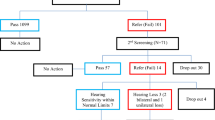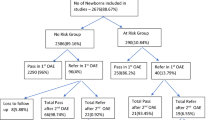Abstract
Objectives
To report experience of implementing universal newborn hearing screening (UNHS) in a tertiary care neonatal unit, identify risk factors associated with failed two-step automated acoustic brainstem response (AABR) screen and evaluate cost of AABR.
Methods
This was a prospective study of UNHS outcomes of all live births with two step AABR using BERAphone MB11®. Outcome measures were screening coverage, refer, pass and lost to follow up rates and cost of AABR using micro-costing method. To identify risk factors for failed screening, authors performed multivariate logistic regression with failed two-step AABR screen as dependent variable and baseline risk factors significant on univariate analysis as predictors.
Results
Screening coverage was moderate (84 %), with 2265 of total 2700 eligible infants screened with initial AABR (mean gestation 37.2 ± 2.3 wk; birth weight 2694 ± 588 g; 305 received nursery care). A total of 273 of 2265 infants were “refer” on first screen. Second screen was done on 233, of which 58 were “refer”. Of these, 35 underwent conventional ABR, of which 5 were diagnosed to have hearing impairment. Only 2 could get hearing aid. Overall, a total of 2197 (81.4 %) infants passed, 496 (18.4 %; excluding 2 deaths) were lost to follow up at various stages, and 5 (0.2 %) were diagnosed with hearing impairment, all of whom were high risk. Average cost of AABR was INR 276 per test. No factor emerged as significant on multivariate analysis.
Conclusions
UNHS is feasible to implement, but significant lost to follow up and non-linkage with appropriate rehabilitation services limit its utility. Cost effectiveness of UNHS compared to high risk based screening needs to be determined.

Similar content being viewed by others
References
World Health Organization. Newborn and infant hearing screening: current issues and guiding principles for action. World Health Organization 2010. Available at www.who.int/blindness/publications/Newborn_and_Infant_Hearing_Screening_Report.pdf. Accessed on 24/12/2014.
Jewel J, Varghese PV, Singh T, Varghese A. Newborn hearing screening—experience at a tertiary hospital in northwest India. Int J Otorhinolaryngol Head Neck Surg. 2013;2:211–4.
Universal hearing screening in newborn. Int J Basic Appl Med Sci. 2013;3:116–21. (http://www.cibtech.org/J-MEDICAL-SCIENCES/PUBLICATIONS/2013/Vol_3_No_2/JMS...17-026...ANIL%20KUMAR...Universal%20hearing%20screening.pdf; last retrieved 10.01. 2015). Accessed 10 Jan 2015.
Augustine AM, Jana AK, Kuruvilla KA, Danda S, Lepcha A, Ebenezer J, et al. Universal neonatal hearing screening - experience in a tertiary care hospital in southern India. Indian Pediatr. 2013. pii: S097475591300554. [Epub ahead of print]
Coenraad S, Toll MS, Hoeve HL, Goedegebure A. Auditory brainstem response morphology and analysis in very preterm neonatal intensive care unit infants. Laryngoscope. 2011;121:2245–9.
American Academy of Pediatrics, Joint Committee on Infant Hearing. Year 2007 position statement: principles and guidelines for early hearing detection and intervention programs. Pediatrics. 2007;120:898–921.
Venkatnarayan K, Sankar MJ, Deorari A, Krishnan A, Paul VK. A micro-costing model of neonatal intensive care from a tertiary Indian unit: feasibility and implications for insurance. Indian Pediatr. 2014;51(3):215–7.
Clemens CJ, Davis SA. Minimizing false-positives in universal newborn hearing screening: a simple solution. Pediatrics. 2001;107:E29.
Paul AK. Early identification of hearing loss and centralized newborn hearing screening facility-the Cochin experience. Indian Pediatr. 2011;48:355–9.
Benito-Orejas JI, Ramírez B, Morais D, Almaraz A, Fernández-Calvo JL. Comparison of two-step transient evoked otoacoustic emissions (TEOAE) and automated auditory brainstem response (AABR) for universal newborn hearing screening programs. Int J Pediatr Otorhinolaryngol. 2008;72:1193–201.
Meier S, Narabayashi O, Probst R, Schmuziger N. Comparison of currently available devices designed for newborn hearing screening using automated auditory brainstem and/or Otoacoustic emission measurements. Int J Pediatr Otorhinolaryngol. 2004;68:927–34.
Lin HC, Shu MT, Lee KS, Ho GM, Fu TY, Bruna S, et al. Comparison of hearing screening programs between one step with transient evoked otoacoustic emissions (TEOAE) and two steps with TEOAE and automated auditory brainstem response. Laryngoscope. 2005;115:1957–62.
Iwsaki S, Hayashi Y, Seki A, Nagura M, Hashimoto Y, Oshima G, et al. A model of two-stage newborn hearing screening with automated auditory brainstem response. Int J Pediatr Otorhinolaryngol. 2003;67:99–104.
Mathur NN, Dhawan R. An alternative strategy for universal infant hearing screening in tertiary hospitals with a high delivery rate, within a developing country, using transient evoked oto-acoustic emissions and brainstem evoked response audiometry. J Laryngol Otol. 2007;121:639–43.
Cebulla M, Shehata-Dieler W. ABR-based newborn hearing screening with MB11 BERAphone® using an optimized chirp for acoustical stimulation. Int J Pediatr Otorhinolaryngol. 2012;76:536–43.
Clemens CJ, Davis SA. Minimizing false-positives in universal newborn hearing screening: a simple solution. Pediatrics. 2001;107:E29.
Nagapoornima P, Ramesh A, Srilakshmi, Rao S, Patricia PL, Gore M, et al. Universal hearing screening. Indian J Pediatr. 2007;74:545–9.
Colgan S, Gold L, Wirth K, Ching T, Poulakis Z, Rickards F, et al. The cost-effectiveness of universal newborn screening for bilateral permanent congenital hearing impairment: systematic review. Acta Paediatr. 2012;12:171–80.
Acknowledgments
The authors would like to thank Ms. Ritu, technician in ENT for doing conventional ABR for the index infants.
Contributions
SG conceptualized and wrote manuscript, SS did AABR and follow up, CPY helped with statistical analysis, AT provided logistic support and also reviewed manuscript, MS, RA, AKD and VKP critically reviewed the manuscript. TS did the cost analysis and MJS provided study oversight and critically reviewed the manuscript. RA will act as guarantor for this paper.
Conflict of Interest
None.
Source of Funding
Indian Council of Medical Research (ICMR), Delhi.
Author information
Authors and Affiliations
Corresponding author
Rights and permissions
About this article
Cite this article
Gupta, S., Sah, S., Som, T. et al. Challenges of Implementing Universal Newborn Hearing Screening at a Tertiary Care Centre from India. Indian J Pediatr 82, 688–693 (2015). https://doi.org/10.1007/s12098-015-1688-4
Received:
Accepted:
Published:
Issue Date:
DOI: https://doi.org/10.1007/s12098-015-1688-4




